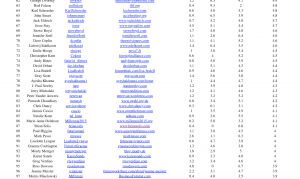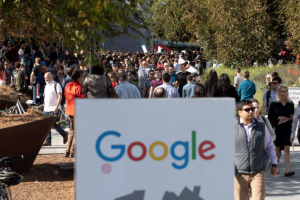
We are now entering an era of sociopolitical influence, a framework for governments that influences and is influenced by its constituencies through real life interaction and now, new media. Some may say that this isn’t anything new. Certain governments over the years embraced the aspects of digital community in Web 1.0 and Web 2.0. Many also believe that President Obama is the first “Social Media” President. I, however, am a far more pragmatic optimist. While many governments and also President Obama have embraced media to learn, interact, and also influence citizens, we are merely at the beginning of a new age of digital democracy where people play an active role in government now and over time.
One of the greatest lessons in social media is that everything begins with listening and such is true for any form of leadership. Governments and their administrations have much to learn. Not only are new media channels rich with insight, they are also interactive. There are people on the other side who have expectations of recognition, acknowledgement, and engagement. As such, the ability for information to come back represents a challenge to many top-down organizations. And, these challenges must be addressed.
Information has historically traveled one-way, from them to you. But, now governments aren’t only learning to listen, they’re exploring means to hear, respond and act. For example, even though the Obama team used social tools to engage with voters during the 2008 election, the channels pushed more than they pulled. Allow me to clarify that statement. The Obama team pushed wonderful content and triggered aspirations and as a result, “pulled” record-breaking donations to help Obama win the Presidency. This is something that I examined at great detail in 2008 for TechCrunch. It’s a wonderful start. The Obama Administration also realizes that the 2012 election will also require that new media channels pivot from top-down to now include bottom-up communication that triggers the A.R.T. of social media: Actions, Reactions, and Transactions.
Interactive engagement is powerful. Without intelligence, however, the ability to transform digital citizens into active stakeholders will prove elusive. In the end, what matters most is that people feel that they were heard and that change was evident. For governments, it’s critical that people are also engaged and directed to take actions that trigger desirable outcomes. In addition to intelligence, social media requires orchestration and the ability to design programs and experiences that positively influence behavior. By activating the human algorithm, governments can inspire a new generation of collaboration and productivity that accomplishes tasks, solves problems, and helps where help is needed. At the same time, the A.R.T. associated with new media programs will trigger a social effect that extends the reach of any political body or organization through the social graphs of engaged citizens potentially influencing friends of friends and audiences of audiences to empathize with efforts and movements.
In June 2011, The White House published a blog post that indicates change is in the air, “What Our Facebook Fans and Twitter Followers Told Us.”
The post begins with a positive note that indicates that the White House is indeed listening in social media:
Over the past few months, we’ve been working to improve the White House’s social media presence to provide our Facebook fans and Twitter followers with timely, relevant and interesting updates about what’s happening at the White House and around the Administration.
The White House conducted a series of surveys with Facebook fans and Twitter followers asking for their feedback on online programs. The two surveys received thousands of responses and the White House social media team shared the highlights.
– 50% of Facebook survey respondents were over the age of 50, with another 35% between 35 and 49.
– The Twitter audience is younger, with only 32% of respondents over the age of 50.
– A combined 62% are over the age of 35.
– 62% reported visiting the White House Facebook page at least once a week.
– 93% read tweets published by the White House at least once a week.
– A significant percentage of Twitter survey respondents are active on Facebook.
– 80% of Twitter followers use Facebook weekly and only 30% of Facebook fans use Twitter weekly.
– Over 50% of respondents from both surveys reported never using Flickr, LinkedIn and social bookmarking sites (such as Digg, Reddit, and Delicious).
– 64% said that the frequency of Facebook posts is “About Right,” with 31% wanting more, and only 5% saying that it’s “Too Much.” 61% of the Twitter survey respondents report that the frequency of posting is “About Right,” with an additional 35% saying it’s “Not Enough,” and only 4% saying that it’s “Too Much.”
– Over 56% share White House Facebook posts on a monthly basis and 78% have shared at least once.
– Only 35% of responders report retweeting @Whitehouse on at least a monthly basis, with only 58% having retweeted at least once.
– The top requested content includes news-oriented posts (Breaking News, the latest news from the Administration), interactive posts (ways to engage with Administration officials, announcement of live streams, quotes from major speeches as they happen) and the Photo of the Day.
Additionally the White House social media team demonstrated transparency by also sharing the thoughts of fans and followers that reveal what they would like to see improved…
On Facebook
“Add a ‘Frequently Asked Questions’ area to answer most questions”
“Please provide more notice for live streaming events. They are great, but only if you get to see them.”
On Twitter
“I appreciate the idea behind tweeting quotes from speeches as they are given, but it might be better served on a Twitter account created just for that purpose. I receive White House tweets via SMS and multiple tweets, and repetition gets a little annoying.”
“It’s been a while since a presidential advisor held twitter chat session or something where we could ask questions during a video chat session.”
To end on a positive note, I believe these words are representative of what should lie ahead…
“It is ‘time’ for the government to realize how much internet is used today. I am grateful for White House’s public involvement in this fashion.”
“I really liked the virtual town hall on Facebook.”
“Love the informal, behind-the-scenes stuff. Nice to know there’s a good man, woman and family leading our free nation.”
“Happy to see this Administration taking advantage of the unique aspects social media presence to interact with public and practice greater transparency.”
This is a promising step indeed. It takes a series of steps to bring about change. As we march toward the progress of progress I encourage the Obama Administration and also any politician or organization to use new media beyond a mechanism for PR or image-driven journalism. These tools represent the ability to empower fans and followers to contribute to relevance of any campaign or mission. In doing so, social networks evolve from information channels to engaged communities with the ability to cause effect and influence behavior. It’s time for #change.
The future of politics isn’t created, it’s co-created.
UPDATE: Interesting story on how Iceland is crowdsourcing its next constitution.
Connect with Brian Solis on Twitter, LinkedIn, Facebook
![]()
___
The New ENGAGE!: If you’re looking to FIND answers in social media and not short cuts, consider either the Deluxe or Paperback edition

___
Get The Conversation Prism:





Ideally The message potency of any integrated communication effort should be rooted in a philosophy of intellectual credibility.The concept of creating an image without the substance to reinforce its existence is likely to produce short term benefits with implications for longer term acceptance and sustainability.Mess with the integrity of the message and be prepared fo the fall out that is most likely to Follow.
I love the thought of actually engaging in conversations with the government and hope that the future really does involve them listening to what is being said. At the same time, those who get involved in the conversations will need to take the time to also listen to what is being said on a global scale so their opinion is well rounded and reflects a broad array of value from many viewpoints. I know for myself, I do not engage, especially in strong opinions on important topics if I have not gotten input from a variety of sources. I want my opinion to be more than just what I have allowed to get through my filters.
Great content Brian! Thanks.
Great post, Brian. I noticed too that the White House is doing a remarkable job with social media. Co-creation has the additional benefit of making fans feel they have something invested, something they’re likely to be loyal to, to own, to spread. Most entities pretend to listen, but I’m proud to see that the WH actually is.
As per usual, a great look into both the depth and breadth of Social Media as a “serious” tool for improving communication, evoking public interest, fostering unique collaboration, and creating avenues for #change. Nicely done, Brian. Thank you.
Cheers!
Graciela, indeed. Sending a delegation to the conference was a positive investment.
Great piece and so full of truth.
Just as social media plays a huge game in changing the face of government, so it does INSIDE the organization. That is if leaders have the courage to listen because in that listening they will hear criticism.
That frequency stat is something to really focus on with any list of fans you have.
It’s a delicate balance narrowing down what’s too much and what’s too little contact with your audience. It’d also be critical to measure when you’re asking people to give you money. Testing this often could make all the difference in record breaking amounts of money pouring in, and a disappointment.
I’m glad I read this post because now I’ve got a reason to follow at least one of these guy’s channels (the one I’m using most frequent) to see how they’re campaign is unfolding and see what I can learn.
Testing
this often could make all the difference in record breaking amounts of money
pouring in, and a disappointment.Thanks to share this blog.
Testing
this often could make all the difference in record breaking amounts of money
pouring in, and a disappointment.Thanks to share this blog.
Testing this often
could make all the difference in record breaking amounts of money pouring in,
and a disappointment.Thanks to share this blog.
Very nice post, many politicians have to read it and accept that the “change” is here and take advantage of social media to learn and communicate more with people, not censoring them, thanks for sharing!